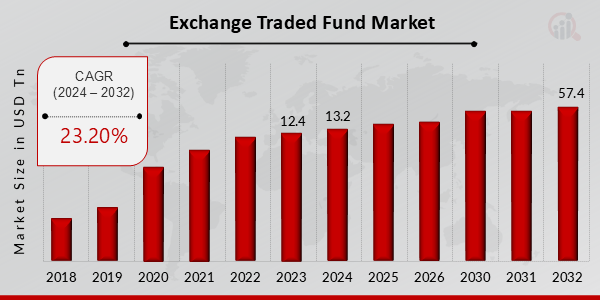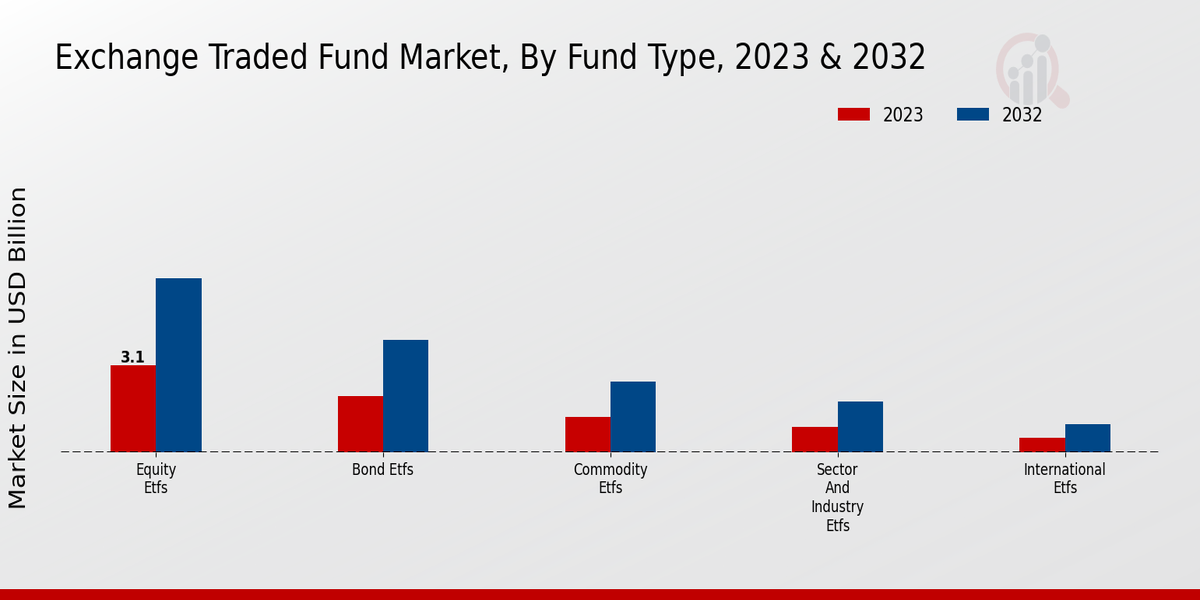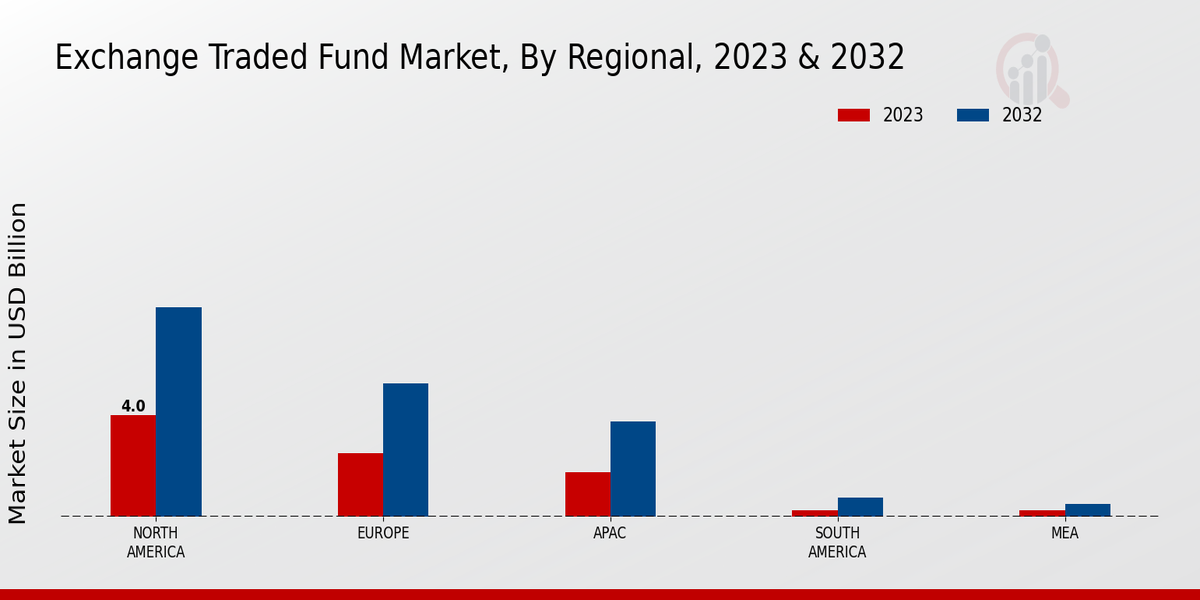Global Exchange Traded Fund Market Overview:
Exchange Traded Fund Market Size was estimated at 12.4 (USD Trillion) in 2023. The Exchange Traded Fund Industry is expected to grow from 13.2 (USD Trillion) in 2024 to 57.4 (USD Trillion) by 2032. The Exchange Traded Fund Market CAGR (growth rate) is expected to be around 23.20% during the forecast period (2024 - 2032).
Key Exchange Traded Fund Market Trends Highlighted
The Exchange Traded Fund Market has a mixture of seasonal and structural factors that are on its growth. Many investors are looking for low-cost options and this is good for ETFs because they usually have lower cost ratios than mutual funds. With investors increasingly apprehending the concepts of diversification and liquidity, ETFs have become the investment of choice. The evolution of passive investing alongside the increasing recognition of responsible investing also helped change the geography of the ETF market for the better. All of these factors suggest that the attitudes of investors are changing in favor of cheaper and more transparent investment methods.
A lot of possibilities are there to be utilized in the growing Exchange Traded Fund Market. One of the key potential areas is the growth of thematic and specialty ETFs that target specifically niche markets like the renewable energy, technology and healthcare industries. This paves a way for new ideas because investment managers can build specific focuses on these ETFs in order to appeal to certain investors in the market. Geographic expansion also offers additional opportunities in this regard, particularly in developing countries with growing investment awareness and product availability. The deployment of technology such as robo advisors can add value on the affordability and simplicity of ETFs thereby broadening the market reach.
Today, the trends within the Exchange Traded Fund Market have changed especially towards ESG (Environmental, Social, and Governance) factors as investors become more socially aware. This has led to the growth of the ETFs oriented towards ESG, which makes it possible to invest in accordance with moral principles. In addition, the era of big data has come, allowing for the development of new products and customer-oriented investment solutions. This is indicative of the trends that are taking place within the financial industry in a more expansive context and serves as a reminder on the need to respond to the changing market in the world of investment.

Source: Primary Research, Secondary Research, MRFR Database and Analyst Review
Exchange Traded Fund Market Drivers
Increasing Popularity of Passive Investment Strategies
The trend toward passive investment strategies has become a significant driver of growth in the Exchange Traded Fund Market Industry. Investors are increasingly shifting from traditional actively managed funds to passively managed funds that track indices. This shift is primarily due to the lower fees associated with index tracking and the evidence that many actively managed funds fail to outperform the market over the long term. As more investors seek cost-efficient ways to grow their portfolios, the demand for ETFs, which inherently align with passive investing principles, continues to rise. Furthermore, institutions and retail investors alike are recognizing the benefits of diversification that ETFs provide, allowing them to invest in a broad range of sectors and asset classes with ease. The evolving digital landscape has streamlined the process for both purchasing and managing ETFs, enhancing their accessibility and appeal. Additionally, the growth of robo-advisors and automated investment services that incorporate ETFs into their offerings has also contributed to the sector's expansion. With ongoing innovations in fund structures and investment strategies, the role of ETFs in the investment ecosystem is ever-expanding, leading to significant market growth projected for the coming years.
Technological Advancements and Accessibility
The Exchange Traded Fund Industry is experiencing rapid growth driven by technological advancements and increased accessibility. Technology has transformed the financial landscape, enabling efficient trading platforms, real-time data analytics, and enhanced user experiences. Online brokerage services have made it simpler for retail investors to trade ETFs, promoting wider adoption. These technological innovations significantly lower trading costs and facilitate better portfolio management, contributing to market expansion.
Regulatory Support and Market Evolution
Regulatory support for the Exchange Traded Fund Market Industry has played a pivotal role in its growth. Increased transparency and investor protection measures have made ETFs more appealing to both institutional and retail investors. This positive regulatory environment encourages new product launches and investments into ETFs, thereby driving market dynamics and enhancing investor confidence in this investment vehicle. As the ETF landscape continues to evolve, support from financial regulators remains crucial for continued growth.
Exchange Traded Fund Market Segment Insights:
Exchange Traded Fund Market Fund Type Insights
The Exchange Traded Fund Market is a robust financial landscape that reflects a significant growth trajectory in the Fund Type segmentation. As of 2023, the overall market is valued at 7.75 USD Billion, revealing the rising popularity and diversification of investment options available to market participants. Among the various Fund Types, Equity ETFs represent a considerable portion of market valuation, holding a value of 3.1 USD Billion in 2023, and are projected to grow to 6.2 USD Billion by 2032. This prominence is largely due to their ability to provide investors with access to a wide array of stock market sectors, enabling them to capitalize on market movements and trends effectively.
Bond ETFs follow, with an initial valuation of 2.0 USD Billion in 2023 and are expected to reach 4.0 USD Billion by the end of the decade. This segment has gained traction due to the demand for fixed-income securities as a stable investment avenue, particularly suitable for conservative investors looking to reduce risk. The Commodity ETFs hold a smaller yet significant portion of the market, valued at 1.25 USD Billion in 2023, and projected to increase to 2.5 USD Billion by 2032. Investors are increasingly looking for ways to hedge against inflation and economic uncertainty, making commodities a strategic part of their portfolios.
Sector and Industry ETFs are also emerging players in the global landscape, with a valuation of 0.9 USD Billion in 2023 and expected growth to 1.8 USD Billion. This niche allows investors to pinpoint particular industries, tapping into sectors like technology or healthcare, which often experience higher volatility and growth potential. Meanwhile, the International ETFs are more modestly valued at 0.5 USD Billion in 2023, with a forecast of reaching 1.0 USD Billion in 2032. These funds provide investors with exposure to foreign markets, making them a vital tool for diversification beyond domestic equities.
The Exchange Traded Fund Market segmentation showcases how dominant Equity ETFs are, holding the majority of the market share, influencing investment patterns significantly. The presence of Bond ETFs caters to the necessity for stable income, while Commodity ETFs respond to market needs for inflation protection. Sector and Industry ETFs capitalize on targeted investments, ultimately allowing investors to align their portfolios with market trends. Meanwhile, International ETFs offer broader horizons, appealing to global-minded investors. This diverse segmentation combined with a favorable market environment suggests increased opportunities for growth and heightened market activities in the coming years.

Source: Primary Research, Secondary Research, MRFR Database and Analyst Review
Exchange Traded Fund Market Investment Strategy Insights
The Exchange Traded Fund Market is showcasing robust growth, with the overall market expected to reach a valuation of 7.75 billion USD in 2023. The Investment Strategy segment plays a pivotal role in this growth, categorizing strategies such as Active Management, Passive Management, Smart Beta, and Thematic Investing. Active Management, characterized by its hands-on approach, allows fund managers to make investment decisions, adapting to market conditions, contributing to its importance in volatility-prone markets. Meanwhile, Passive Management seeks to replicate the performance of market indices, appealing to cost-conscious investors. Smart Beta strategies incorporate systematic factors for portfolio optimization, emphasizing the blending of active and passive management benefits. Thematic Investing focuses on specific trends or themes, resonating with investors’ preferences towards sustainable and growth-oriented sectors. These strategies reflect the dynamic nature of investor preferences, with increasing demand for tailored investment solutions driving the importance and evolution of the Exchange Traded Fund Market segmentation. The sustained growth in these areas is influenced by factors such as technological advancements, investor education, and a growing awareness of alternative investment opportunities, thereby shaping the overall industry landscape.
Exchange Traded Fund Market Distribution Channel Insights
The Exchange Traded Fund Market, valued at 7.75 USD Billion in 2023, reveals notable dynamics concerning its distribution channels. The primary distribution methods can be categorized into Online Brokers, Financial Advisors, and Institutional Investors, each contributing uniquely to market growth. Online Brokers have gained prominence due to their accessibility and the rise of digital trading platforms, enabling a growing number of retail investors to participate in the market. Meanwhile, Financial Advisors play a crucial role by offering tailored guidance and portfolio management services to individual investors, greatly influencing investment decisions. Additionally, Institutional Investors dominate the market, as their substantial capital allocations and investment strategies directly affect the liquidity and attractiveness of exchange-traded funds. This diverse range of distribution channels enhances the overall efficiency and reach of the Exchange Traded Fund Market, leading to significant trends driven by technology, investor education, and the growing interest in passive investment strategies. As these channels evolve, they present opportunities for innovation and market expansion, making them integral to the overall industry landscape.
Exchange Traded Fund Market Investor Type Insights
The Exchange Traded Fund Market, valued at 7.75 USD Billion in 2023, is witnessing diverse participation across various Investor Types, which significantly influences its growth trajectory. Among these, Retail Investors play a crucial role as they seek cost-effective investment options, allowing easier access to a range of funds. Institutional Investors, on the other hand, dominate the market with substantial assets under management, reflecting their confidence in ETFs for diversification and liquidity. High-Net-Worth Individuals are notable for their strategic investments in specialized ETFs, utilizing these funds to optimize their portfolios. The interplay of these Investor Types showcases a robust market landscape, fueled by increasing awareness, favorable regulatory changes, and technological advancements that simplify trading processes. Recent trends signify a shift towards sustainable and thematic ETFs, capturing the attention of all investor types, while the continued expansion of online trading platforms enhances market accessibility. However, challenges such as market volatility and the need for comprehensive financial education persist, presenting both potential risks and opportunities for stakeholders within the Exchange Traded Fund Market industry. The evolving dynamics and preferences of these Investor Types continue to shape Exchange Traded Fund Market statistics and data crucial for future market growth.
Exchange Traded Fund Market Regional Insights
In 2023, the Exchange Traded Fund Market is valued at 7.75 USD Billion, characterized by significant contributions from its Regional segmentation. North America leads the market with a valuation of 4.0 USD Billion, representing a majority holding that underscores its dominance in the Exchange Traded Fund Market. Europe follows with a valuation of 2.5 USD Billion, reflecting its significant influence on shaping market trends. Meanwhile, the APAC region holds a valuation of 1.75 USD Billion, capturing growing interest due to emerging economies and increased investor participation. South America and MEA account for smaller valuations at 0.25 USD Billion and 0.25 USD Billion, respectively, highlighting their developing markets with potential for growth as local investors become more familiar with Exchange Traded Funds. As the Exchange Traded Fund Market data demonstrates, the overall regional insights reveal diverse opportunities and challenges, with North America and Europe driving most of the market growth, while APAC presents untapped potential for expansion, linearly growing towards an expected valuation of 3.75 USD Billion by 2032.

Source: Primary Research, Secondary Research, MRFR Database and Analyst Review
Exchange Traded Fund Market Key Players and Competitive Insights:
The Global Exchange Traded Fund (ETF) Market has shown a significant evolution over recent years, characterized by a surge in product offerings, investor interest, and innovations in trading technology. This sector has attracted a wide range of participants, from institutional investors to individual retail traders, as ETFs provide an efficient investment vehicle that combines the flexibility of trading like a stock with the diversification benefits typical of mutual funds. Competition in this market is dynamic, with numerous players striving to differentiate their offerings through lower costs, enhanced performance tracking, and specialized ETFs that cater to niche investment strategies. The growing demand for sustainable and socially responsible investing has also led to increased competition, as providers seek to create funds that align with these values. In this vibrant landscape, companies continually adapt to shifting investor preferences and technological advancements, establishing their presence through innovative solutions and strategic partnerships. Northern Trust has solidified its position within the Exchange Traded Fund Market by leveraging its strong reputation for trust, integrity, and robust asset management capabilities. The company employs a unique approach focused on delivering tailored ETF solutions that meet the specific needs of institutional and retail clients. Northern Trust's strength lies in its comprehensive research capabilities, allowing the company to offer ETFs that align with evolving market demands while focusing on performance and transparency.
The organization's commitment to operational excellence is complemented by its extensive experience in managing a diverse range of asset classes, which enhances its appeal to investors seeking reliable options in the ETF space. Furthermore, Northern Trust emphasizes strategic partnerships and collaborations, ensuring its products remain competitive by continuously innovating and adapting to investor needs. On the other hand, Vanguard Group has emerged as a significant powerhouse in the Exchange Traded Fund Market, known for its low-cost investment options and a strong commitment to investor education. Vanguard's enduring philosophy revolves around providing investors with superior returns through passive investment strategies, particularly index-tracking ETFs, which minimize fees and maximize market exposure.
The company's extensive range of ETFs cover a variety of sectors and asset classes, making it a preferred choice for a diverse clientele seeking efficient investment vehicles. Vanguard is also recognized for its investor-friendly practices, as it often leads to fostering transparency and aligning its services with the best interests of the investor community. Moreover, the firm actively participates in advocating for sound investment principles, which enhances its credibility and market presence amidst increasing competition in the ETF market, reinforcing its reputation as a leader in investment management and innovation.
Key Companies in the Exchange Traded Fund Market Include:
Exchange Traded Fund Industry Developments
Recent developments in the Global Exchange Traded Fund (ETF) Market reveal a dynamic landscape marked by increasing competition and investment. Vanguard Group and BlackRock are actively enhancing their ETF offerings, focusing on Sustainable and thematic investments to attract environmentally-conscious investors. Meanwhile, JPMorgan Chase has recently launched innovative ETFs aimed at capturing growth in emerging sectors, responding to evolving market demands. In terms of mergers and acquisitions, State Street Global Advisors has been reported to be considering strategic acquisitions to expand its footprint in niche markets, reflecting a broader trend among major players such as Franklin Templeton and Invesco, who are also exploring partnerships for growth. Northern Trust and BNY Mellon have emphasized enhancing their technological capabilities to better meet client needs, indicating a rise in demand for digital services in ETF management. The growth of ETFs continues to gain momentum, as seen in Fidelity Investments and Goldman Sachs expanding their product lines, benefiting from increased investor interest which further solidifies their market positioning. The overall market is becoming increasingly competitive, with firms adapting quickly to capitalize on trends in sustainability and technology.
Exchange Traded Fund Market Segmentation Insights
-
Exchange Traded Fund Market Fund Type Outlook
-
Equity ETFs
-
Bond ETFs
-
Commodity ETFs
-
Sector and Industry ETFs
-
International ETFs
-
Exchange Traded Fund Market Investment Strategy Outlook
-
Active Management
-
Passive Management
-
Smart Beta
-
Thematic Investing
-
Exchange Traded Fund Market Distribution Channel Outlook
-
Online Brokers
-
Financial Advisors
-
Institutional Investors
-
Exchange Traded Fund Market Investor Type Outlook
-
Exchange Traded Fund Market Regional Outlook
-
North America
-
Europe
-
South America
-
Asia Pacific
-
Middle East and Africa
| Report Attribute/Metric |
Details |
| Market Size 2023 |
12.4 (USD Trillion) |
| Market Size 2024 |
13.2 (USD Trillion) |
| Market Size 2032 |
57.4 (USD Trillion) |
| Compound Annual Growth Rate (CAGR) |
23.20% (2024 - 2032) |
| Report Coverage |
Revenue Forecast, Competitive Landscape, Growth Factors, and Trends |
| Base Year |
2023 |
| Market Forecast Period |
2024 - 2032 |
| Historical Data |
2019 - 2023 |
| Market Forecast Units |
USD Trillion |
| Key Companies Profiled |
Northern Trust, Vanguard Group, BlackRock, JPMorgan Chase, Franklin Templeton, Deutsche Bank, State Street Global Advisors, BNY Mellon, WisdomTree, Goldman Sachs, Fidelity Investments, Morgan Stanley, Invesco, Raymond James, Charles Schwab |
| Segments Covered |
Fund Type, Investment Strategy, Distribution Channel, Investor Type, Regional |
| Key Market Opportunities |
Emerging market investments, Sustainable and ESG funds, Increased retail investor participation, Technological advancements in trading, Diversification through sector ETFs |
| Key Market Dynamics |
increasing investor interest, lower fees, tax efficiency, diverse investment options, regulatory developments |
| Countries Covered |
North America, Europe, APAC, South America, MEA |
Frequently Asked Questions (FAQ) :
The Exchange Traded Fund Market is expected to be valued at 57.4 USD Trillion in 2032.
The expected CAGR for the Exchange Traded Fund Market is 23.20% from 2024 to 2032.
In 2023, North America holds the largest market share, valued at 4.0 USD Billion.
The market size for Equity ETFs is forecasted to reach 6.2 USD Billion in 2032.
Key players in the market include Northern Trust, Vanguard Group, BlackRock, and JPMorgan Chase, among others.
The market size for Bond ETFs is valued at 2.0 USD Billion in 2023.
The APAC region is expected to grow to 3.75 USD Billion by 2032.
The market size for Commodity ETFs is expected to be 2.5 USD Billion in 2032.
International ETFs are valued at 0.5 USD Billion in 2023.
Current market dynamics and changes in investor preferences may pose challenges to market growth.

















